Two Champions of Children Are Given Nobel Peace Prize
- By DECLAN WALSH - The New York Times - October 10, 2014
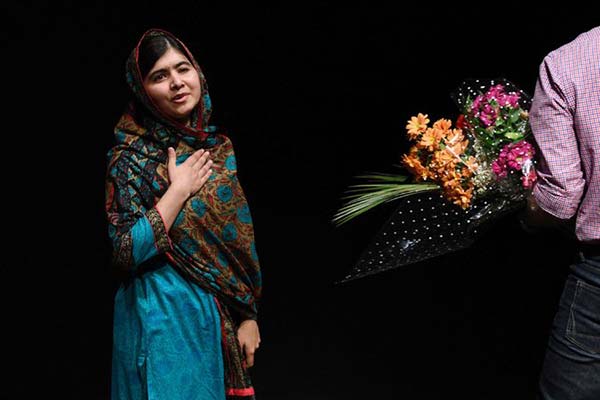 Malala Yousafzai, 17, said she was honored to be the youngest person to receive the award. She dedicated it to the “voiceless.”
Malala Yousafzai, 17, said she was honored to be the youngest person to receive the award. She dedicated it to the “voiceless.”
“Who is Malala?” shouted the Taliban gunman who leapt onto a crowded bus in northwestern Pakistan two years ago, then fired a bullet into the head of Malala Yousafzai, a 15-year-old schoolgirl and outspoken activist.
That question has been answered many times since by Ms. Yousafzai herself, who survived her injuries and went on to become an impassioned advocate, global celebrity and, on Friday, the latest recipient of the Nobel Peace Prize alongside the Indian child rights campaigner Kailash Satyarthi.
Yet since that decisive gunshot in October 2012, Ms. Yousafzai and her compelling story have been reshaped by a range of powerful forces — often, though not always, for good — in ways that have left her straddling perilous fault lines of culture, politics and religion.
In Pakistan, conservatives assailed the schoolgirl as an unwitting pawn in an American-led assault. In the West, she came to embody the excesses of violent Islam, or was recruited by campaigners to raise money and awareness for their causes. Ms. Yousafzai, guided by her father and a public relations team, helped to transform that image herself, co-writing a best-selling memoir.
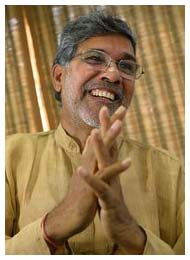 And now the Nobel Prize committee has provided a fresh twist on her story, recasting her as an envoy for South Asian peace.
And now the Nobel Prize committee has provided a fresh twist on her story, recasting her as an envoy for South Asian peace.
Announcing the prize in Oslo on Friday, the committee chairman, Thorbjorn Jagland, said it was important for “a Hindu and a Muslim, an Indian and a Pakistani, to join in a common struggle for education and against extremism” — a resonant message in a week in which the Pakistani and Indian armies have exchanged shellfire across a disputed stretch of border, killing 20 villagers. But it was also a message that highlighted how far Ms. Yousafzai has come from her original incarnation as the schoolgirl who defied the Taliban and lived to tell the tale.
Amid the debate about the politics of her celebrity, few question the heroism of Ms. Yousafzai — a charismatic and exceptionally eloquent teenager who has followed an astonishing trajectory since being airlifted from Pakistan’s Swat Valley. At just 17, she has visited with President Obama and the queen of England, addressed the United Nations, and become the youngest recipient of the Nobel Peace Prize since it was created in 1901.
She learned of her award on Friday when a teacher called her from a chemistry lesson at Edgbaston High School for Girls in Birmingham, the English city she now calls home.
“I was totally surprised when she told me, ‘Congratulations, you have won the Nobel Peace Prize, and you are sharing it with a great person who is also working for children’s rights,’ ” Ms. Yousafzai said at a news conference.
She will share the $1.1 million prize with Mr. Satyarthi, 60, a veteran, soft-spoken activist based in New Delhi who has rescued trafficked children from slavery.
“If with my humble efforts the voice of tens of millions of children in the world who are living in servitude is being heard, congratulations to all,” Mr. Satyarthi said in a television interview on Friday.
There had been some speculation that the Nobel committee, which last year gave the prize to the Organization for the Prohibition of Chemical Weapons, might withhold it this year, as it did in 1972 during the Vietnam War.
Yet Ms. Yousafzai offered an emotional counterpoint to grinding conflict in Syria, Iraq and elsewhere. “With her courage and determination, Malala has shown what terrorists fear most: a girl with a book,” said Ban Ki-moon, the United Nations secretary general.
In Pakistan, she has come to symbolize the country’s existential struggle against Islamist violence. She rose to prominence in 2009 as the author of an anonymous blog that described life in Swat at a time when fighters, armed with Kalashnikovs, terrorized the valley’s residents and shut schools where girls were being educated.
Later, she became a national news media figure, speaking about the need for peace, which drew her into the Taliban’s cross hairs. In the summer of 2012, the insurgents hatched a plan to kill her, then put it into action that October.
After the shooting, with life-threatening wounds to her head, Ms. Yousafzai was flown to Britain for treatment. But back in Pakistan, a news media-driven backlash had already started, some of it by crude conspiracy theories — accusations that the teenager was a C.I.A. agent, a blasphemer or a traitor.
But more reasonable people were discomfited, too — in particular by the way Western news media outlets lionized Ms. Yousafzai at a time when American drones were pounding targets in the tribal areas, sometimes killing civilians.
“Malala’s story, and the way it was framed, fitted neatly into a certain Western narrative,” said Ziyad Faisal, an economics student in Milan, Italy. “But at the end of the day, she’s just a teenage girl. She means so many things to so many people.”
After surgeons inserted a titanium plate in her head, Ms. Yousafzai made a rapid recovery, and quickly drowned out her critics with her preternatural poise and speaking skills. She shifted her focus, moving away from the fight against the Taliban and toward a broader advocacy for children. An alliance with Gordon Brown, the former British prime minister turned education campaigner, honed a message she continued to deliver on Friday.
“This award is for all those children who are voiceless, whose voices need to be heard,” she said. “I speak for them, and I stand up with them.”
But that advocacy — important yet politically inoffensive — has also drawn sharp criticism from those who say that the choice of Ms. Yousafzai exemplifies the way the Nobel Prize has strayed far from the purpose intended by Alfred Nobel, the Swedish chemist who invented dynamite and who originated the prize.
“This is not for fine people who have done nice things and are glad to receive it,” said Fredrik Heffermehl, a Norwegian jurist who has written a book on the prize. “All of that is irrelevant. What Nobel wanted was a prize that promoted global disarmament.”
Nonetheless, for the many Pakistanis and Indians who enthusiastically hailed the joint win by Ms. Yousafzai and Mr. Satyarthi, it was a welcome taste of what unites, rather than divides their countries: a shared interest in education and in improving the plight of millions of downtrodden and abused children. And for Ms. Yousafzai, it brings her story full circle, back to South Asia.
Once-cynical voices in Pakistan were drowned out on Friday by a chorus of well-wishers. “A bright moment in dark times,” said Nadeem Farooq Paracha, a news media commentator, on Twitter.
But a few clung to the old conspiracy theories. “Her shooting was a ready-made drama that was created by foreign powers,” said Ghulam Farooq, a newspaper editor in Ms. Yousafzai’s hometown, Mingora.
Others noted ironies — that Pakistan’s previous Nobel Prize winner, a scientist from the minority Ahmadi community, had been shunned for his religious beliefs, and that for all of her travel, the one country that Ms. Yousafzai cannot visit, for security reasons, is her own.
“Maybe Malala can come home now?” said Sharmeen Obaid Chinoy, a Pakistani filmmaker who won an Academy Award in 2012.
Declan Walsh reported from Kabul, Afghanistan. Alan Cowell contributed reporting from Berlin; Nida Najar from New Delhi; Sana ul Haq from Swat Valley, Pakistan; Ismail Khan from Peshawar, Pakistan; and Somini Sengupta from New York.
It is Time to Declassify Those 28 Pages
Seeking the American government’s analysis of the 9/11 attacks, most people look to the 9/11 Commission Report. There is, however, another report that merits equal attention: the Joint Inquiry into Intelligence Community Activities Before and After the Terrorist Attacks of September 11, 2001.
President George W. Bush censored 28 pages of this report—an entire section said to describe the involvement of specific foreign governments in the attacks. After reading it, Congressman Thomas Massie described the experience as “disturbing” and said, “I had to stop every two or three pages and rearrange my perception of history…it’s that fundamental.”
In the interest of achieving justice for victims and preventing future attacks, knowledge of foreign government involvement in 9/11 must be shared with the American people…and with the world.
28Pages.org was launched in July 2014 to help build awareness of this classified material and to bolster the growing, bipartisan movement to pressure Congress and the President to finally disclose it. Use 28Pages.org to study the issue, follow efforts to declassify the 28 pages and learn how you can help pressure the government to do the right thing.
Surprise! Effort in Congress to Declassify 9/11 Evidence
There is a bi-partisan effort to declassify and release the 28 redacted pages from the Senate Joint Inquiry on 9/11. This report preceded the 9/11 Commission investigation. Rep. Walter Jones (R-NC) and Steven Lynch (D-MA) have introduced HR 428. It currently has 17 co-sponsors who have signed onto the resolution which calls for the 28 pages. Former Sen. Bob Graham (D-FL) has been lobbying for its release since 2003. Many 9/11 families have come together to launch a law suit aimed at a key issue found in the 28 pages - the money trail behind 9/11.
For all who have followed the alternative research into 9/11, this should be of great interest. Finally, there is political action being taken on a key 9/11 issue, which can potentially lead to a wide range of questionable issues about what many deem as the most consequential event of our time.
For a good source of information, visit www.28pages.org. This site was launched by a 9/11 family member. There are resources and actions we can take to put pressure on Congress to take further action. Ideally, if we write letters to our representatives prior to the November elections, we can insist they support HR 428 if they want our vote! Then even after that point, we can continue to apply pressure, especially on Speaker John Boehner because it will require his support to call it to a vote.
Next, please sign this petition at Whitehouse.gov. Please help this go viral. If 100,000 signatures are gathered by Oct. 31, 2014, it will be seen by the general public and presented to President Obama who has been stonewalling the release of the 28 pages.
https://petitions.whitehouse.gov/petition/declassify-28-classified-pages-911-commission/2VQYlSKN
Democracy requires truth, transparency, and a judicial system that holds no one above the law. It's our move.
Signs of "Connected Consciousness" Detected on Global Scale
- By Richard Samson - September 28, 2014
 |
Our individual minds, though distinct and uniquely ours, may also join with others in a kind of mental symphony that now and then becomes audible against a prevailing background of static. That's a conclusion suggested by the Global Consciousness Project (GCP), which got its start at Princeton University in 1998 and now operates as an international collaboration. |
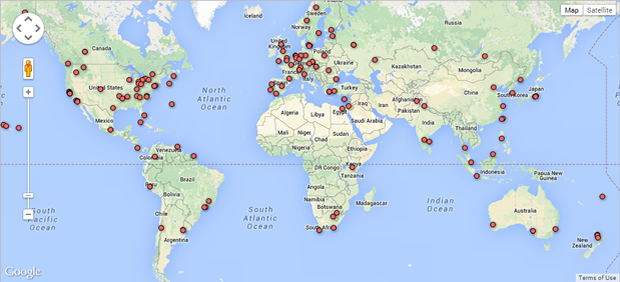
Global Consciousness Project locations
After 16 years of monitoring more than 480 world events, researchers report strong evidence of some kind of transpersonal mentality that seems to emerge when many people share a common concern or experience. At such times, a global network of devices employing quantum tunneling has found weak but definite signs of coherence arising out of background "noise" or randomness.
Although the evidence has been known by specialists for years, it has grown so strong it now warrants public attention. And it comes at a time when the materialistic assumptions of traditional science, particularly physics, are being challenged.
The measured effect, though faint and fickle, is statistically significant to an extremely high degree, according to the researchers. It shows up during times of crisis or celebration, such as an earthquake or New Year's Eve, when millions of people focus on the same thing at the same time.
Although far from final and definitive, the research suggests that our minds may not be bounded by our heads but somehow extend out into the world and commingle, at least at times. "What we can interpret from our experiments is that we really are interconnected," says Roger Nelson, GCP's Director. "Human beings are simply not isolated islands of consciousness."
The Research in a Nutshell
The detection system is a global network of random number generators (RNGs) based on quantum tunneling. Up to 70 are active at any one time. Each RNG outputs a continuous stream of completely unpredictable zeroes and ones. The stream ordinarily averages out at 50% ones and 50% zeros, just as flipping coins tends to produce roughly equal heads and tails over time. The RNG data are transmitted to a central archive for later analysis.
When events engage millions of minds and hearts at once, structure seems to emerge out of what would otherwise be randomness. The global network departs a bit from the normal generation of random ones and zeros. The RNGs' behaviors become slightly correlated and the system as a whole appears to shift toward coherence.
It doesn't happen every time, but often enough and strongly enough to produce compelling statistics. The chart below shows the combined output of the RNG network before, during and after 9/11/2001, the day the Pentagon and World Trade Center were attacked. The odds that the apparent structure in the project database for that day is due to chance are about one in 32, considered statistically significant. When this event's data are combined with that of other events studied on other days, the odds against chance rise exponentially.
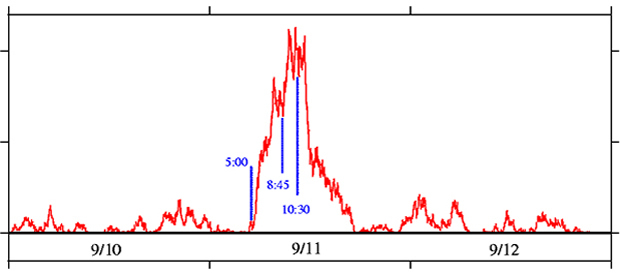
Output of Global Consciousness Project computers on 9/11/2001
Image source: Global Consciousness Project
Many types of events have been studied: natural disasters, religious holidays, airline crashes, military invasions, acts of terror, peace vigils, and political events such as Obama winning the presidency in 2008. The chart below summarizes the aggregate results of all studies.
The jagged red line shows the accumulating excess of empirically developed scores relative to expectation for the complete dataset of defined events. The odds against chance are more than a trillion to one, after more than 480 studies. As additional events have been studied, the degree of significance has steadily increased.
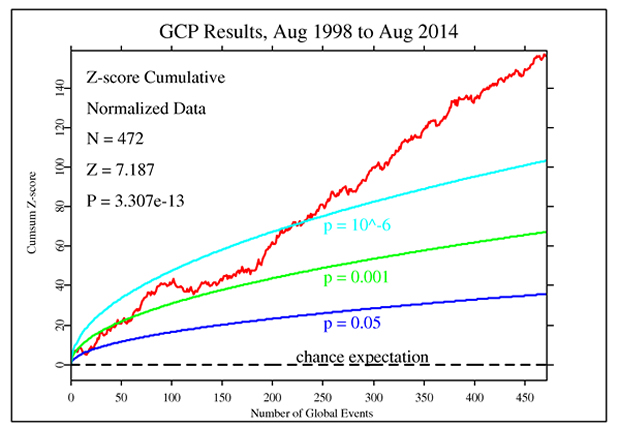
Aggregate results of Global Consciousness Project studies through August 2014
Image source: Global Consciousness Project
All efforts to invalidate the data or the conclusions have so far failed. For example, the team compared earthquakes that occurred under the ocean to those occurring on land. The prediction was that only the land-based quakes would produce a significant effect, since quakes at sea have hardly any impact on people. The RNG readings validated this prediction.
No one knows exactly why and how such deviations from chance happen. But they do. For a more detailed description, see the Deeper Explanation section, below. For complete information, see the Global Consciousness Project.
The Bottom Line?
"We can conclude," says Nelson, "that there really are effects of consciousness in the world, unexpected correlations in our network of random devices. Something is going on, and the most likely conclusion is that there is an interconnection of consciousness at deeply hidden levels between people and among people across the globe."
Why Is It News Now?
Results of the GCP studies have been published on many occasions over the past 16 years, but never widely noted by the general media. Now may be the time to start paying attention.
Why? For one thing, the statistical certainty has mounted to the point that it's hard to ignore. Toward the end of 1998, the odds against chance started exceeding one in 20, an acceptable level in many disciplines. Then, with added studies, the level of certainty began to zoom. By the year 2000, the odds against chance exceeded one in 1,000; and in 2006, they broke through the one in a million level; they're now more than one in a trillion with no upper limit in sight.
This far exceeds the bar for statistical significance used in many fields, such as medicine and weather forecasting. Odds against chance ranging from 20-to-one to 100-to-one are commonly considered sufficient. The certainty level is set unusually high for the Higgs Boson; data for validating its existence are considered acceptable if they exceed one in 3.5 million. The GCP level of statistical certainty is now more than 285,000 times greater than that.
In addition to the mounting weight of the evidence, there's another reason it may be newsworthy now. It could help alter a mindset that perpetuates our problems. As Nelson puts it, "The more we understand we're all 'one,' as the sages of all cultures put it, the better able we'll be to shift our activities to realize our huge, wonderful potential." Without a course change, he adds, "we may not have a future at all."
Long-term Significance
Small indications often portend big developments. Tenuous evidence of connected consciousness might be the sprouting seed of something. What?
An early student of global awareness was Pierre Teilhard de Chardin, 1881-1955, the French philosopher, Jesuit priest, paleontologist and geologist. Teilhard refined Vladimir Vernadsky's concept of noosphere (the ultimate sphere of consciousness) and conceived the idea of the Omega Point. That's the level of maximum complexity, coherence and consciousness that would be the end point of evolution, he said. Aided by technology and prompted by population growth, the earth as a whole would eventually become conscious, embracing and enriching each individual's awareness, Teilhard argued.
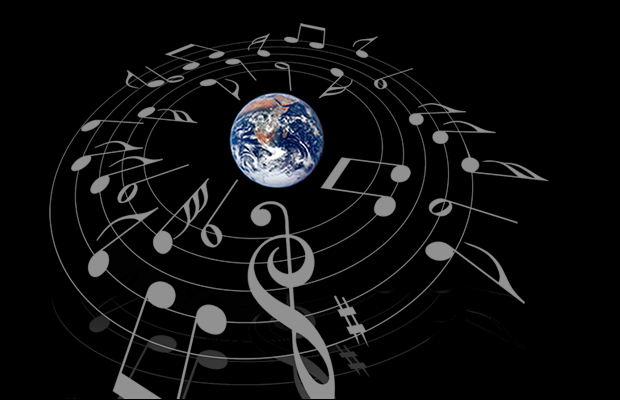
Is a "mental symphony" tuning up?
Image sources: musical notes, ClipArt Best; earth, NASA
Nelson speculates that we may be witnessing the first flickers of such an eventuality. "What we see in the global consciousness correlations may be some very faint version of Teilhard's noosphere," he says. It may take 10,000 years to materialize, he cautions. But we might enjoy the flickers along the way.
Social Implications Today
Solid evidence that consciousness is global and mutual could have a salutary effect by prompting reconsideration of the assumption dominating our era: that matter rules. But what if mind rules? That's the big question implied by the research; and a widespread consideration of it could prove liberating.
Toward that end and with the noosphere vision in mind, now may be the time, Nelson suggests, for a shift from biological evolution to conscious evolution – the intentional enhancement of individual, group, and global consciousness. "To make a real difference," he says, "what we'd need are perhaps 100 million people, out of the seven billion on the planet, all becoming deeply persuaded and able to work on a kind of conscious evolution strategy."
A realistic optimist, Nelson also offers a more modest proposal. "What we can all do," he says, "is learn to live in the world in a positive, accepting fashion, in which case the world will roll out toward its future, taking us along on a probably more pleasant ride."
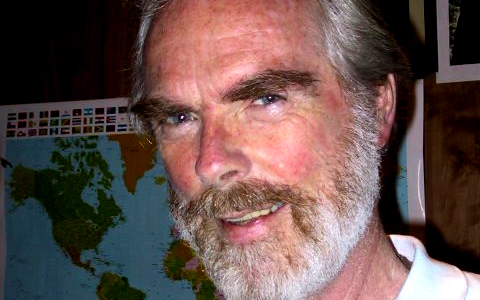
Roger Nelson, GCP Director
Image source: Global Consciousness Project
Research Background
Controlled laboratory research on interactions of consciousness with physical random systems began in the 1960's. Helmut Schmidt at Boeing Laboratories conducted the first large database experiments, followed by other researchers through the 60's and 70's.
In 1979, Robert Jahn established the Princeton Engineering Anomalies Research (PEAR) laboratory at Princeton University. A key aim was to study whether sensitive electronic devices might be affected by special states of consciousness including strong emotions and directed intention. Nelson joined the PEAR group in 1980.
In the late 1990's Nelson and others laid the groundwork for what became the Global Consciousness Project (GCP). Co-developers include Greg Nelson, John Walker, Dean Radin, Paul Bethke, Richard Adams, Peter Bancel, and Rick Berger. The full list includes many others. A logistical home for the GCP is provided by the Institute of Noetic Sciences (IONS), founded by Apollo 14 astronaut Edgar Mitchell.
Much more research needs to be done, Nelson says. With increased public attention and funding, new knowledge and practical outcomes could accelerate.
Deeper Explanation
Nelson supplies a more nuanced picture of the research in a Q-and-A exchange with the author:
SAMSON: You have said your research reveals signs of a conscious influence, but it's not something that should be called mental "signals." Could you explain?
NELSON: Technically, we analyze the random data produced by the devices, and we discover weak or subtle signals emerging from the noise that the devices are designed to produce. The actual nature of the signals is correlations that should not exist between the devices. So the devices have not actually "found" signals; they are the source of the noise or signals that sometimes arise during moments of shared emotion and functional mass consciousness.
SAMSON: How, exactly, are the periods of mass consciousness manifested in the data?
NELSON: What distinguishes such moments is that the behaviors of the far-flung RNGs become slightly correlated. We don't look directly at the proportion of ones or zeros. We just calculate a composite measure of variance across all the RNGs in the network. That variance measure responds to mean shifts in either direction and more so if two or more RNGs shift in the same direction. It is as if a (non-energetic) field blanketed the whole earth and thus all the RNGs in the GCP network, and subtly modulated their behavior.
The basic effects we see in the data are more complicated than changing the percentage of ones and zeros, and indeed we don't look for such changes directly. What we measure is best described as correlated changes of the RNG behavior. That is, the RNGs, which are designed to be fundamentally independent random sources, and which are moreover separated by global distances (average separation 7,000 kilometers), ought to have completely independent behaviors. BUT, what we see is that they tend to become very slightly correlated during great world events.
These "random" devices become slightly synchronized, apparently as if in sympathy with the synchronized mass consciousness. In many ways, this is more remarkable and more instructive than simple deviations or extra bits here and there. But it is considerably more complicated to explain than an excess of heads when flipping coins.
SAMSON: What's the overall importance of the findings, in your view?
NELSON: In the end, the important thing is that the network of physical instruments becomes different; it changes, apparently because of interconnected or synchronized consciousness. The essential thing is that consciousness is not separate from the world, just looking on. It is enmeshed and instrumental, and we should know that so we can use it, to get on with becoming the sheath of intelligence (noosphere) for the earth. That is our terribly important work as human beings -- our evolutionary destiny, as Teilhard de Chardin put it.
* * *
This article is the one of a series on consciousness breakthroughs and their impact on the issues of our day. Stay tuned for more.
The shift to a new perspective on consciousness is a key component of the highly-human megatrend that is now possible -- the shift to an era of enhanced health, mind, science, economy, culture, and living. For an overview, see Spectacular "Supersociety" Possible Thanks to Highly-Human Shift?
About the Author
Richard Samson is director of the EraNova Institute and has served as a consultant to IBM, AT&T, and other large organizations. His work appears in the SuperLife social network; the Highly-Human Focus website (formerly Highly-Human Jobs); and The Futurist Magazine, published by the World Future Society. His books include The Mind Builder, Creative Analysis, The Language Ladder, and Mind Over Technology.
Copyright World Future Society
7910 Woodmont Avenue, Suite 450,
Bethesda, Maryland 20814
301-656-8274
Monsanto Poised To Take Over the Cannabis Industry
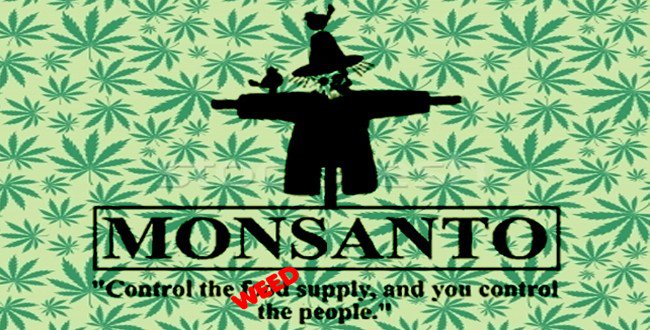
- By Richie Holterman - September 29, 2014
Monsanto Poised To Take Over the Weed Industry
Earlier in August, my great home state of Illinois joined the party and legalized medical marijuana, becoming the 20th state in the nation to do so. With most of the rest of the thirty straggling states now trying to push forward some kind of legislation, and with Washington and Colorado both taking the unprecedented step to outright legalize it, and with CNN’s Dr. Sanjay Gupta officially climbing on board the Green Express by saying that he believes it has legitimate medicinal properties, the nationwide legalization of marijuana is less of a hope and more of an inevitability. At some near point in the future, most likely one that takes place in our own lifetimes, the use of marijuana will be as prevalent as cigarettes, alcohol, and aspirin.
And, as anyone who’s ever stepped foot in a bar or liquor store or hospital knows, that means big corporations jockeying for your money.
As this report from CNBC makes clear, there’s tons of money in pot. It’s the so-called “largest cash crop in California” for a reason: the cultivation of marijuana plants in Mendocino County alone is theorized to reach roughly $1.5 billion a year. Seeing as no one has a perfect understanding of just how many plants are being grown up there, that estimate may actually be low. And with that much money hanging around, corporate interests are sure to follow.
What the CNBC report surmises, then, is that what has happened with the coffee/beer/wine industry is going to happen to the marijuana one: Small artisan growers get a jump-start and make big profits for a few years before large corporations buy them out, create partial monopolies, and dominate the industry from that point forward.
Legal commercial production in the U.S. is currently handled by a patchwork of small farmers. While there have been rumors for years of big agricultural firms buying up land ahead of legalization, it would still take time to develop a mass production product, and even more time to build a Maxwell House-like brand that would come to dominate that market.
Dominate they will, unless something drastic changes with the state of the country’s fundamental economic philosophy. That’s just the current way of our world. But there’s actually a distinct possibility that those artisan developers aren’t even going to get their handful of glory days before big business takes over. And the swift market domination may come from one of our favorite genetic-engineering corporate super giants:Monsanto.
The move certainly makes sense on a logical level. At its core, marijuana is an agricultural product. It’s a crop. And that’s a system that Monsanto, as detailed time and time again in these parts, specializes in gaming. As far as the “technological advancements” they’re working on in order to put themselves ahead of the game:
The company is investing millions of dollars into this new technology dubbed “RNAi.” With RNAi, it is possible to manipulate everything from the color of the plant to making the plant indigestible to insects. With medical marijuana, RNAi could be used to create larger, more potent plants effectively cornering the market and exceeding the legal demand for the plant.
Picture the future: Marijuana-laced edibles being sold at Ralph’s — behind some kind of glass case, of course — that have not only been made with GMO-infused peanut butter and Rice Krispies and flour, but the marijuana itself has been raised with genetically-modified seedlings. That kind of product doesn’t seem like what cancer patients and other ill individuals will be looking forward to digesting to dull the pain. (We’re talking about medical marijuana here, after all.)
Which means that maybe the main issue we’ll be eventually dealing with is not whether we should have access to medical marijuana at all, but whether we should have easier access to medical marijuana that’s organic and GMO-free.
Monsanto Giving Up On Europe
Despite my best intentions to keepthe fight over GMOs from devolving into a bunch of over-the-top rhetoric, it’s really, really, really hard to look at what Monsanto/DuPont & Friends are doing and not compare it to a war. The battle lines are distinct (GMO corporations vs. consumer-minded activists), the stakes are incredibly high (what our world eats), there’s plenty of propaganda being dropped (too much to sum up here within a proper parenthetical length), and the conflict has become a struggle over turf.
For instance, not only has Monsanto been trying toobtain a controlling stake in the soon-to-be-quite-profitable marijuana industry, they’ve also been attempting to get a foothold in the European market. (This, after all, is how corporations work; the answer to “do we have enough money yet?” is a boisterous “no!” followed by a slap in the face for asking such a silly question.) To spread their wings across the globe, they’ve been taking the tactics that work here in the U.S. — attempting to court/buy lobbyists to help guide the laws in their direction — and trying to translate them overseas.
But what makes the European theater of war different, is that their tactics didn’t work.
Monsanto recently announced they will no longer be trying to apply to grow new GM-crops in Europe. This brings to a screeching halt their attempt to develop “six types of corn, a soybean variety, and a modified sugar beet” in the European market.
Instead:Monsanto will now focus its European efforts on its conventional agriculture business and on enabling the import of GM crops for use as animal feed, a widespread EU practice that is less controversial than cultivating the crops in European fields.
As is the case with any business, the top dog in the field dictates how the rest will line up. Thusly, DuPont has also essentially quit the European game for the time being. So, if you’re in the anti-GMO camp, your reaction should be as follows: “Hooray! We win! The battle is over! Let’s all get on the plane, go home, kiss our significant other — or others, I don’t know how you live your life! — and have a good night’s sleep!”
This “win” is not the happy ending that comes with any Katherine Heigl movie. It’s more reminiscent of the finale of “The Wire,” actually. (And if you need a warning about spoilers for a TV show that (a) enough people should have guilt-tripped you into watching by now; and (b) is five years in the ground, consider this as that.) That show’s end had plenty of happy moments: Bubbles is welcomed back into his family; Daniels and Rhonda still together; McNulty retired; the evil Marlo left without street cred; Carcetti a newly-elected Governor. But those small victories are couched in the knowledge that nothing in the city of Baltimore — more accurately, the War on Drugs — has really changed.
Small victories do not mean the war is over.
So, despite the good news on the European front for anti-GMO activists, there’s still an awful lot to be weary about. Namely, the fact that Monsanto/Dupont & Friends have taken whatever investments they were planning on making in Europe and shifting them elsewhere.
First on the list:Africa, where Monsanto has attempted to flood the continent’s markets with their Roundup product. (And we’ve already seen what kinds of court battles come on the heels of that.) DuPont, meanwhile, spent their new reservoir of cash to buy a controlling share of South Africa’s largest seed company, Pannar:
It gives the chemicals company a large handhold over maize, one of the most important crops on the continent, three-quarters of which is already genetically modified. DuPont, through its Pioneer Hi-Bred division, now has control over one of the largest collections of genetic resources for the crop.
Also, Africa isn’t the only place on the globe where GMO corporations are trying to expand:
Monsanto has also made a $150 million investment in the Ukraine where it is bringing Europe’s largest seed production plant on line.
So, no. The battle has not been won with GMOs withdrawal from Europe. The focal point has just shifted slightly.
As far as what to do with this news? Well, the next March Against Monsanto is set to take place Saturday, October 12. Checking it out — and if you’re in L.A., here’s information about where to go — is a good start.
Source:
http://www.kcet.org/living/food/food-rant/monsanto-to-take-over-the-weed-industry.html
http://www.kcet.org/living/food/food-rant/monsanto-giving-up-on-europe.html


